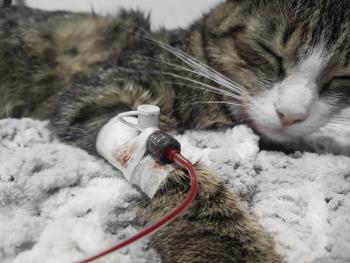
AFAST3 for you and me
Since ultrasonography is becoming more accessible to all veterinary practitioners, learn all about this ultrasonographic examination protocol for trauma and start saving lives.
Most veterinarians are schooled on ARDS, SIRS and other common medical acronyms. But are you ready for FAST3?
FAST, which stands for focused assessment with sonography for trauma, is a rapid bedside ultrasonographic examination and screening test for blood-or other abnormalities-after trauma. More specifically, there are the abdominal FAST (AFAST), thoracic FAST (TFAST) and Vet BLUE (bedside lung ultrasound exam) techniques that have evolved to the FAST3 techniques-focused assessment with sonography in triage, tracking and trauma.
Why is it important?
Why all the fuss with name changes and the fancy superscript 3? Although I often agree with infomercials, especially at 4 a.m. after a 16-hour shift, Ron Popeil was wrong. As clinicians, we can't just “set it and forget it” in medicine. We need not only rapid initial triage and assessment, but also constant reassessment and tracking of our patients. We understand that the hypotensive, shocky patient may not have a definitive hemoabdomen on presentation. Rather it may take some time after fluid resuscitation for hemorrhage to present within a body cavity.
Focusing on the AFAST3 technique, why has this become so important in both human and veterinary medicine? There are clear limitations and concerns when moving a critically ill patient to radiology where it needs to be taped, sand-bagged or manually restrained to obtain diagnostic imaging results. Human and veterinary studies have demonstrated that radiographic serosal detail is not sensitive or specific at detecting abdominal fluid after blunt trauma (Figure 1).1,2
1. A radiograph from a 8.5-year-old spayed female English springer spaniel. Note the mild gas and fluid dilation of the stomach. The small bowel appears empty to mildly thickened or mildly fluid dilated. There is moderate remodeling of both hips with thickened femoral necks. Diagnostic impressions: Increased fluid in the stomach may be due to gastritis or pancreatitis. There is no evidence of foreign material or obstruction. Incidental moderate chronic hip arthritis is present.
Ultrasonography is thought to be a more ideal initial imaging modality as it can be performed simultaneously while other assessments are being performed and while resuscitative measures are provided. Importantly, there is no requirement to be a fancy board-certified radiologist to perform the ultrasound procedure. Non-radiologist veterinarians can be quickly trained to performed the AFAST3 ultrasound to make life-saving clinical decisions.3
How does it work?
Now that I have your attention and before you head to eBay for an ultrasound machine, let's discuss how to perform the AFAST3. The patient is placed in right lateral recumbency to evaluate four specific sites within the abdomen (Figure 2):
1) Diaphragmatic-hepatic (DH)
2) Spleno-renal (SR)
3) Cysto-colic (CC)
4) Hepato-renal (HR)
2. The four areas evaluated on the FAST technique: diaphragmatic-hepatic (DH), spleno-renal (SR), cysto-colic (CC) and hepato-renal (HR).
The sites are evaluated in a clockwise motion as you look for evidence of effusion, which is typically identified as anechoic (black) areas around the identified organ structures (Figure 3). Remember, this is a quick and dirty evaluation. Shaving the patient is not required. A little alcohol or ultrasound gel is sufficient, although it is important to remember to avoid alcohol if the patient is critical and may require defibrillation (or has injuries including abrasions or lacerations).
3. An ultrasonogram from a 10-year-old spayed female American bulldog. Multiple hypoechoic masses are seen throughout the liver measuring 1 to 4 cm. Mild effusion is present, seen here with an anechoic appearance.
Does it work?
I can see you are questioning these statements with the appropriate critical eye. Is this really better? Does this improve my patient evaluation? The answer-yes! In a prospective study of 100 dogs presenting for motor vehicle trauma, a FAST examination was found to have 96% sensitivity and 100% specificity for the detection of free abdominal fluid.4
Further studies were performed to determine the likelihood of the traumatic hemoperitoneum patient requiring a transfusion.1 A fluid scoring system was described for the AFAST3 procedure, with one point given for hemorrhage at each of the four locations described above. An abdominal fluid score (AFS) of 0 means there is no effusion at any of the sites. An AFS of 4 means fluid was present at all four sites. Dogs with traumatic hemoperitoneum with an AFS of 1 or 2 are considered major-injury, small-volume bleeders and rarely become anemic from the intra-abdominal hemorrhage. Alternatively, dogs that had an AFS of 3 or 4 are considered to be major-injury, large-volume bleeders and are more likely to become anemic. In this study, about 25% of patients with AFS scores 3 or 4 developed anemia severe enough to require transfusion therapy.
Serial examinations (tracking) cannot be overemphasized. It's standard of care to repeat FAST examinations four hours after admission in all stable cases to make certain an AFS of 1 or 2 is not developing into a 3 or 4. The take-home message: If a patient has an AFS of 3 or 4, be prepared with blood products, a blood donor or the possibility to transfer the patient to another hospital to provide transfusion therapy.
Are you ready for ultrasound?
Yes! If you are intimidated by technology and ultrasonography, there are numerous courses available for practicing veterinarians, not only as wet and dry labs at conferences but as online courses such as fastvet.com and textbooks with images and protocols.5
Although ultrasonography is not 100% sensitive for intra-abdominal hemorrhage, it is practically perfect for recognizing intra-abdominal hemorrhage after trauma. An ultrasonographic examination provides a rapid assessment, which may not only improve patient care, but can be life-saving.
Garret Pachtinger, VMD, DACVECC, is the COO of VETgirl. He is an associate at Veterinary Specialty and Emergency Center in Levittown, Pennsylvania.
References
1. Lisciandro GR, Lagutchik MS, Mann KA, et al. Evaluation of an abdominal fluid scoring system determined using abdominal focused assessment with sonography for trauma in 101 dogs with motor vehicle trauma. J Vet Emerg Crit Care 2009;19(5):426-437.
2. Soderstrom CA, DuPriest RW Jr, Cowley RA. Pitfalls of peritoneal lavage in blunt abdominal trauma. Surg Gynecol Obstet 1980;151(4):513-518.
3. Shackford SR, Rogers FB, Osler TM, et al. Focused abdominal sonogram for trauma: the learning curve of nonradiologist clinicians in detecting hemoperitoneum. J Trauma 1999;46(4):553-564.
4. Boysen SR, Rozanski EA, Tidwell AS, et al. Evaluation of focused assessment with sonography for trauma protocol to detect free abdominal fluid in dogs involved in motor vehicle accidents. J Am Vet Med Assoc 2004; 225(8):1198-1204.
5. Lisciandro GR. Focused ultrasound techniques for the small animal practitioner. Hoboken, New Jersey: Wiley-Blackwell, 2014.
Newsletter
From exam room tips to practice management insights, get trusted veterinary news delivered straight to your inbox—subscribe to dvm360.




